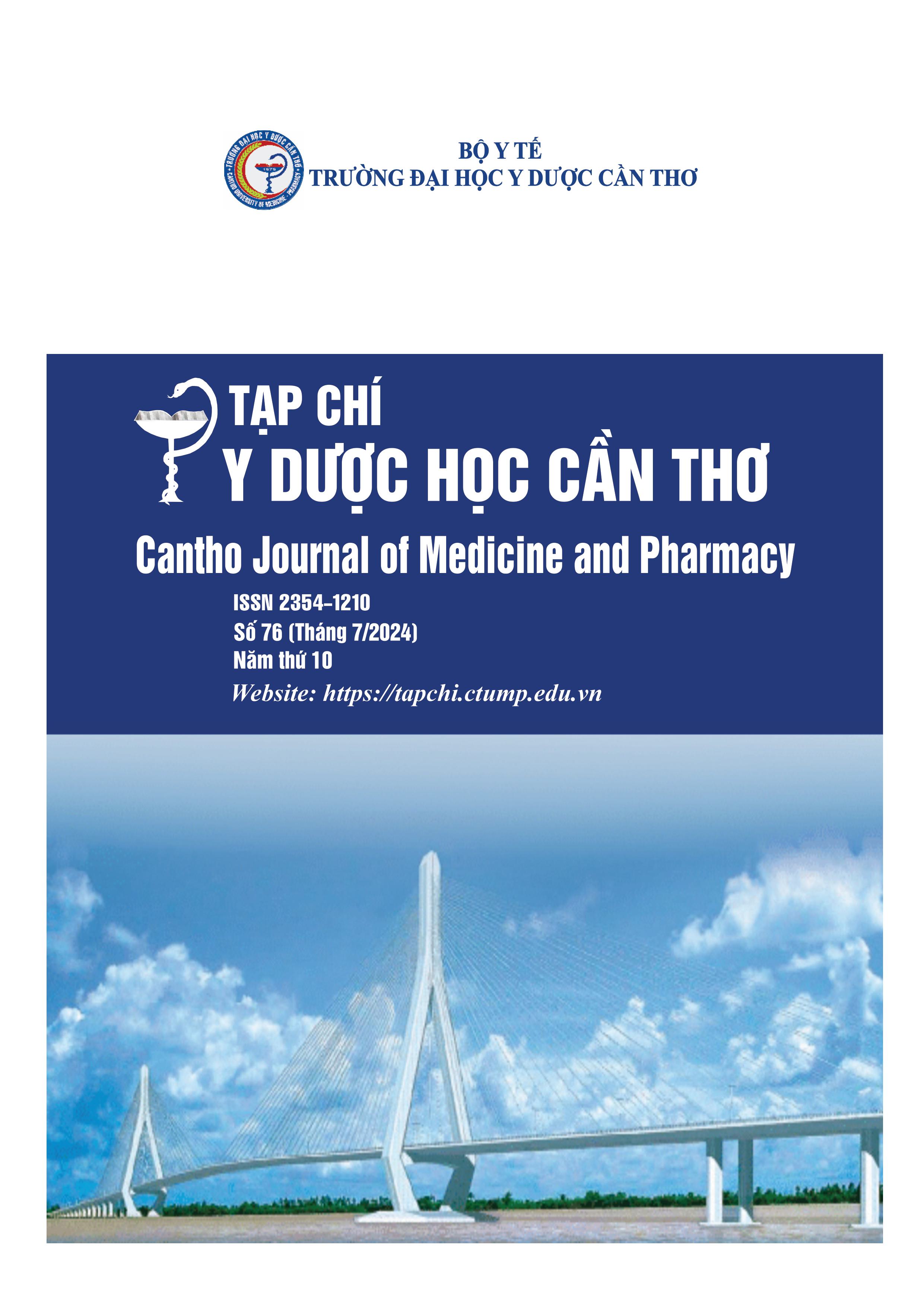MỘT SỐ YẾU TỐ LIÊN QUAN ĐẾN MỨC ĐỘ NẶNG VÀ KẾT QUẢ ĐIỀU TRỊ TRẺ NHIỄM TOAN CETON DO ĐÁI THÁO ĐƯỜNG TYPE 1 TẠI BỆNH VIỆN NHI ĐỒNG CẦN THƠ
Nội dung chính của bài viết
Tóm tắt
Đặt vấn đề: Nhiễm toan ceton do đái tháo đường (Diabetic Ketoacidosis: DKA) là nguyên nhân hàng đầu gây bệnh tật và tử vong ở trẻ em mắc bệnh đái tháo đường đường type 1 (Type 1 Diabetes Mellitus: T1DM). Chẩn đoán kịp thời, đánh giá lâm sàng và sinh hóa toàn diện cũng như quản lý hiệu quả là chìa khóa để giải quyết thành công DKA. Mục tiêu nghiên cứu: Khảo sát một số yếu tố liên quan đến mức độ nặng và nhận xét kết quả điều trị trẻ DKA tại Bệnh viện Nhi đồng Cần Thơ. Đối tượng và phương pháp nghiên cứu: Nghiên cứu hàng loạt ca bệnh được tiến hành trên 31 bệnh nhi được chẩn đoán DKA do T1DM điều trị nội trú tại Bệnh viện Nhi đồng Cần Thơ từ năm 2021-2024. Kết quả: Nguy cơ DKA mức độ nặng của nhóm trẻ dưới 5 tuổi cao hơn nhóm từ 5 tuổi trở lên là 1,5 (95% CI: 0,13-16,54); nữ giới cao hơn nam giới là 3 (95% CI: 0,63-14,12); trẻ sống ở nông thôn cao hơn trẻ sống ở thành thị là 2,46 (95% CI: 0,41-14,63); chẩn đoán nhầm cao hơn nhóm chẩn đoán ban đầu đúng là 2,81 (95% CI: 0,28-27,97). Thời gian hết toan trung bình là 24,08 giờ, khác nhau có ý nghĩa thống kê giữa các nhóm mức độ DKA (p<0,05). Biến chứng DKA bao gồm: tổn thương thận cấp (80,6%), hạ kali máu (80,6%), hạ glucose máu (58,1%), phù não (6,5%), không có bệnh nhân tử vong. Kết luận: Trẻ nhỏ, giới nữ, khả năng tiếp cận y tế khó khăn (địa dư nông thôn) và chẩn đoán nhầm trì hoãn điều trị là các yếu tố nguy cơ làm tăng nguy cơ DKA mức độ nặng. Hạ glucose máu, hạ kali máu và tổn thương thận cấp là các biến chứng thường gặp trong DKA.
Chi tiết bài viết
Từ khóa
Đái tháo đường type 1, nhiễm toan ceton do đái tháo đường, T1DM, DKA
Tài liệu tham khảo
2. Kostopoulou E., Sinopidis X., Fouzas S., Gkentzi D., Dassios T., et al. Diabetic Ketoacidosis in Children and Adolescents; Diagnostic and Therapeutic Pitfalls. Diagnostics (Basel). 2023. doi: 10.3390/diagnostics13152602.
3. Wolfsdorf J. I., Glaser N., Agus M., Fritsch M., Hanas R., et al. ISPAD Clinical Practice Consensus Guidelines 2018: Diabetic ketoacidosis and the hyperglycemic hyperosmolar state.
Pediatr Diabetes. 2018. 19 Suppl 27, 155-177, doi: 10.1111/pedi.12701.
4. Libman I., Haynes A., Lyons S., Pradeep P., Rwagasor E., et al. ISPAD Clinical Practice Consensus Guidelines 2022: Definition, epidemiology, and classification of diabetes in children and adolescents. Pediatr Diabetes. 2022. 23 (8), 1160-1174, doi: 10.1111/pedi.13454.
5. Glaser N., Fritsch M., Priyambada L., Rewers A., Cherubini V., et al. ISPAD clinical practice consensus guidelines 2022: Diabetic ketoacidosis and hyperglycemic hyperosmolar state. Pediatr Diabetes. 2022. 23 (7), 835-856, doi: 10.1111/pedi.13406.
6. Lee H. J., Yu H. W., Jung H. W., Lee Y. A., Kim J. H., et al. Factors Associated with the Presence and Severity of Diabetic Ketoacidosis at Diagnosis of Type 1 Diabetes in Korean Children and Adolescents. J Korean Med Sci. 2017. 32 (2), 303-309, doi: 10.3346/jkms.2017.32.2.303.
7. Lawrence J. M., Divers J., Isom S., Saydah S., Imperatore G., et al. Trends in Prevalence of Type 1 and Type 2 Diabetes in Children and Adolescents in the US, 2001-2017. Jama. 2021. 326 (8), 717-727, doi: 10.1001/jama.2021.11165.
8. Cherubini V., Grimsmann J. M., Åkesson K., Birkebæk N. H., Cinek O., et al. Temporal trends in diabetic ketoacidosis at diagnosis of pediatric type 1 diabetes between 2006 and 2016: results from 13 countries in three continents. Diabetologia. 2020. 63 (8), 1530-1541, doi:
10.1007/s00125-020-05152-1.
9. Usher-Smith J. A., Thompson M. J., Sharp S. J., et al.Walter F. M. Factors associated with the presence of diabetic ketoacidosis at diagnosis of diabetes in children and young adults: a systematic review. Bmj. 2011. 343. d4092, doi: 10.1136/bmj.d4092.
10. Kao K. T., Islam N., Fox D. A., et al.Amed S. Incidence Trends of Diabetic Ketoacidosis in Children and Adolescents with Type 1 Diabetes in British Columbia, Canada. J Pediatr. 2020. 221, 165-173.e162, doi: 10.1016/j.jpeds.2020.02.069.
11. Ganesh R., Arvindkumar R., Vasanthi T. Clinical profile and outcome of diabetic ketoacidosis in children. Natl Med J India. 2009. 22 (1). 18-19.
12. Hsia D. S., Tarai S. G., Alimi A., Coss-Bu J. A., et al.Haymond M. W. Fluid management in pediatric patients with DKA and rates of suspected clinical cerebral edema. Pediatr Diabetes. 2015. 16 (5), 338-344, doi: 10.1111/pedi.12268.
13. Myers S. R., Glaser N. S., Trainor J. L., Nigrovic L. E., Garro A., et al. Frequency and Risk Factors of Acute Kidney Injury During Diabetic Ketoacidosis in Children and Association With
Neurocognitive Outcomes. JAMA Netw Open. 2020. 3 (12), e2025481, doi: 10.1001/jamanetworkopen.2020.25481.
14. Huang J. X., Casper T. C., Pitts C., Myers S., Loomba L., et al. Association of Acute Kidney Injury During Diabetic Ketoacidosis With Risk of Microalbuminuria in Children With Type 1 Diabetes. JAMA Pediatr. 2022. 176 (2), 169-175, doi: 10.1001/jamapediatrics.2021.5038.
15. Wolfsdorf J., Craig M. E., Daneman D., Dunger D., Edge J., et al. Diabetic ketoacidosis in children and adolescents with diabetes. Pediatr Diabetes. 2009. 10 Suppl 12, 118-133, doi:
10.1111/j.1399-5448.2009.00569.x.


